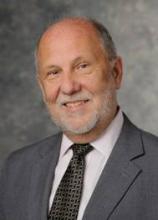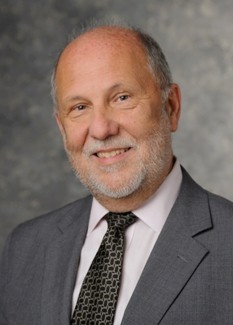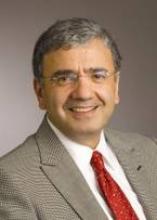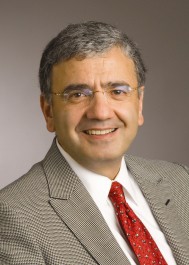User login
New therapies bolster the melanoma armamentarium
Community Oncology Editor Dr. Jame Abraham spoke with Dr. Michael Postow at the Oncology Practice Summit in Las Vegas about new immuno- and targeted therapies for melanoma, their side effects, and early phase studies of emerging therapies.
The Oncology Practice Summit was the 8th annual meeting of Community Oncology, the journal of clinical issues in community practice. Dr. Abraham was a co-chair of the Summit, which was hosted this year by Community Oncology as well as The Journal of Supportive Oncology, and The Oncology Report.
Community Oncology Editor Dr. Jame Abraham spoke with Dr. Michael Postow at the Oncology Practice Summit in Las Vegas about new immuno- and targeted therapies for melanoma, their side effects, and early phase studies of emerging therapies.
The Oncology Practice Summit was the 8th annual meeting of Community Oncology, the journal of clinical issues in community practice. Dr. Abraham was a co-chair of the Summit, which was hosted this year by Community Oncology as well as The Journal of Supportive Oncology, and The Oncology Report.
Community Oncology Editor Dr. Jame Abraham spoke with Dr. Michael Postow at the Oncology Practice Summit in Las Vegas about new immuno- and targeted therapies for melanoma, their side effects, and early phase studies of emerging therapies.
The Oncology Practice Summit was the 8th annual meeting of Community Oncology, the journal of clinical issues in community practice. Dr. Abraham was a co-chair of the Summit, which was hosted this year by Community Oncology as well as The Journal of Supportive Oncology, and The Oncology Report.
ED post-concussion instructions lacking
Approximately 30% of concussive patients discharged from the emergency department aren't given proper instruction to prevent further injury. That's according to Dr. Ilene Claudius, assistant professor and emergency department pediatrician at the University of Southern California, Los Angeles. At the 2013 Advanced Pediatric Emergency Medicine Assembly, Dr. Claudius offered some guidance for physicians providing sideline consultation on sports-related head injuries.
Approximately 30% of concussive patients discharged from the emergency department aren't given proper instruction to prevent further injury. That's according to Dr. Ilene Claudius, assistant professor and emergency department pediatrician at the University of Southern California, Los Angeles. At the 2013 Advanced Pediatric Emergency Medicine Assembly, Dr. Claudius offered some guidance for physicians providing sideline consultation on sports-related head injuries.
Approximately 30% of concussive patients discharged from the emergency department aren't given proper instruction to prevent further injury. That's according to Dr. Ilene Claudius, assistant professor and emergency department pediatrician at the University of Southern California, Los Angeles. At the 2013 Advanced Pediatric Emergency Medicine Assembly, Dr. Claudius offered some guidance for physicians providing sideline consultation on sports-related head injuries.
Integrating palliative care in the ED
As physicians and hospitals increase their focus on palliative care programs, many are still wary about the practice. At the 2013 Advanced Pediatric Emergency Medicine Assembly, Dr. Patricia O'Malley, director of pediatric palliative care services at Massachusetts General Hospital, said palliative care in the emergency department is critical, and physicians should use a focused approach when initiating these difficult conversations.
As physicians and hospitals increase their focus on palliative care programs, many are still wary about the practice. At the 2013 Advanced Pediatric Emergency Medicine Assembly, Dr. Patricia O'Malley, director of pediatric palliative care services at Massachusetts General Hospital, said palliative care in the emergency department is critical, and physicians should use a focused approach when initiating these difficult conversations.
As physicians and hospitals increase their focus on palliative care programs, many are still wary about the practice. At the 2013 Advanced Pediatric Emergency Medicine Assembly, Dr. Patricia O'Malley, director of pediatric palliative care services at Massachusetts General Hospital, said palliative care in the emergency department is critical, and physicians should use a focused approach when initiating these difficult conversations.
Head, neck infections rising among children
Pediatricians in the emergency room are seeing more complicated head and neck infections, and more often. That's according to Dr. Keith Borg, emergency medicine physician and assistant professor at the Medical University of South Carolina. He gave some tips to choosing the best course of diagnosis and treatment.
Pediatricians in the emergency room are seeing more complicated head and neck infections, and more often. That's according to Dr. Keith Borg, emergency medicine physician and assistant professor at the Medical University of South Carolina. He gave some tips to choosing the best course of diagnosis and treatment.
Pediatricians in the emergency room are seeing more complicated head and neck infections, and more often. That's according to Dr. Keith Borg, emergency medicine physician and assistant professor at the Medical University of South Carolina. He gave some tips to choosing the best course of diagnosis and treatment.
Migraines, heart disease increasing in children
Poor diet and lack of regular exercise are bringing more children and adolescents into emergency departments with lifestyle-related illnesses such as migraines, heart disease, and kidney stones, explains Dr. Richard Cantor, director of pediatric emergency medicine services at University Hospital in Syracuse, N.Y.
Poor diet and lack of regular exercise are bringing more children and adolescents into emergency departments with lifestyle-related illnesses such as migraines, heart disease, and kidney stones, explains Dr. Richard Cantor, director of pediatric emergency medicine services at University Hospital in Syracuse, N.Y.
Poor diet and lack of regular exercise are bringing more children and adolescents into emergency departments with lifestyle-related illnesses such as migraines, heart disease, and kidney stones, explains Dr. Richard Cantor, director of pediatric emergency medicine services at University Hospital in Syracuse, N.Y.
Doctors Undertrained, but Still Needed in Antismoking Efforts
WASHINGTON – While doctors can serve a critical role in advocating for their patients to stop smoking, most aren’t trained on how to do so, according this year’s Tobacco Atlas, a report detailing tobacco’s effects on health care and global economics.
The report, now in its fourth edition, was published by the World Lung Foundation and the American Cancer Society.
Dr. Judith L. Mackay, The Tobacco Atlas coauthor and a senior policy adviser to the World Health Organization, said smoking cessation training, is missing from undergraduate and graduate medical schooling, and hence, from the exam room.
"[Doctors] might say to [their patients] ‘Smoking is harmful’ but there’s a whole manner of tips and advice, groups that can be set up, [and] pharmaceutical agents that can be used, where countries can afford it. ... But if you’re not trained in knowing them and understanding them and how to use them, there’s a massive gap between the needs of the patients and then the actual ability of the health profession to basically help them, Dr. Mackay said in an interview at a Washington briefing on the Tobacco Atlas.
She added that physicians should also receive training in health advocacy.
"Doctors are not taught how to make a representation to a finance minister, to put the tax up. They’re not taught how to run a press conference. They’re not basically taught how to do interviews ... and yet what can be more important than getting our health messages to the right people, whether they be government or whether they be the media."
Michael Eriksen, Sc.D., lead author of the report, also suggested that one of the easiest ways for physicians to address tobacco use is to treat it as a vital sign during physician encounters and monitor it accordingly.
The report defines five steps physicians should actively take with patients:
• Ask about tobacco use.
• Advise patients to quit and inform them on the health risks.
• Assess the patient’s willingness to quit.
• Assist the patient in quitting through pharmacologic and counseling measures.
• Arrange for follow-up and monitor the patient’s progress.
When considering effective measures to help patients quit, Dr. Eriksen advised that pharmacologic measures alone have only a 6% success rate, compared with 20% for patients who take medication and also attend antismoking groups and 10% for those who only attend a group.
Outside of clinical measures, however, Dr. Eriksen said physicians can be effective advocates for policy changes, such as clean indoor air laws, tobacco education in schools, and state-level tobacco tax increases. He added that patients with tobacco-related conditions often don’t survive long enough to advocate on their own behalf.
"The chest physicians who deal with the devastation are powerful advocates for changing the status quo," said Dr. Eriksen, who serves as dean of the Institute of Public Health at Georgia State University, Atlanta. "If you’re in a community where you do both [clinical monitoring and advocacy], that’s really going to have a double-barreled impact on success rates and getting people to quit smoking." Dr. Eriksen is also former director of the Office on Smoking and Health and is currently a consultant at the Centers for Disease Control and Prevention.
As advocates for smoking cessation, physician can also have a lasting affect on the healthcare system, according to Keith Hansen, the World Bank’s director of human development in Latin America and the Caribbean.
"[Health care] puts tremendous strain on the state, which has to pay for expensive health services much earlier than it should if we prevent these [tobacco-related] illnesses. And, of course, it’s a tremendous drain on the health system," Mr. Hansen said.
The report details that, in the United States, cigarette smoking was responsible for $193 billion in annual health-related losses, including $96 billion in direct medical costs, from 2000 to 2004. This represents nearly 5% of total health care expenditures from 2003-2008.
WASHINGTON – While doctors can serve a critical role in advocating for their patients to stop smoking, most aren’t trained on how to do so, according this year’s Tobacco Atlas, a report detailing tobacco’s effects on health care and global economics.
The report, now in its fourth edition, was published by the World Lung Foundation and the American Cancer Society.
Dr. Judith L. Mackay, The Tobacco Atlas coauthor and a senior policy adviser to the World Health Organization, said smoking cessation training, is missing from undergraduate and graduate medical schooling, and hence, from the exam room.
"[Doctors] might say to [their patients] ‘Smoking is harmful’ but there’s a whole manner of tips and advice, groups that can be set up, [and] pharmaceutical agents that can be used, where countries can afford it. ... But if you’re not trained in knowing them and understanding them and how to use them, there’s a massive gap between the needs of the patients and then the actual ability of the health profession to basically help them, Dr. Mackay said in an interview at a Washington briefing on the Tobacco Atlas.
She added that physicians should also receive training in health advocacy.
"Doctors are not taught how to make a representation to a finance minister, to put the tax up. They’re not taught how to run a press conference. They’re not basically taught how to do interviews ... and yet what can be more important than getting our health messages to the right people, whether they be government or whether they be the media."
Michael Eriksen, Sc.D., lead author of the report, also suggested that one of the easiest ways for physicians to address tobacco use is to treat it as a vital sign during physician encounters and monitor it accordingly.
The report defines five steps physicians should actively take with patients:
• Ask about tobacco use.
• Advise patients to quit and inform them on the health risks.
• Assess the patient’s willingness to quit.
• Assist the patient in quitting through pharmacologic and counseling measures.
• Arrange for follow-up and monitor the patient’s progress.
When considering effective measures to help patients quit, Dr. Eriksen advised that pharmacologic measures alone have only a 6% success rate, compared with 20% for patients who take medication and also attend antismoking groups and 10% for those who only attend a group.
Outside of clinical measures, however, Dr. Eriksen said physicians can be effective advocates for policy changes, such as clean indoor air laws, tobacco education in schools, and state-level tobacco tax increases. He added that patients with tobacco-related conditions often don’t survive long enough to advocate on their own behalf.
"The chest physicians who deal with the devastation are powerful advocates for changing the status quo," said Dr. Eriksen, who serves as dean of the Institute of Public Health at Georgia State University, Atlanta. "If you’re in a community where you do both [clinical monitoring and advocacy], that’s really going to have a double-barreled impact on success rates and getting people to quit smoking." Dr. Eriksen is also former director of the Office on Smoking and Health and is currently a consultant at the Centers for Disease Control and Prevention.
As advocates for smoking cessation, physician can also have a lasting affect on the healthcare system, according to Keith Hansen, the World Bank’s director of human development in Latin America and the Caribbean.
"[Health care] puts tremendous strain on the state, which has to pay for expensive health services much earlier than it should if we prevent these [tobacco-related] illnesses. And, of course, it’s a tremendous drain on the health system," Mr. Hansen said.
The report details that, in the United States, cigarette smoking was responsible for $193 billion in annual health-related losses, including $96 billion in direct medical costs, from 2000 to 2004. This represents nearly 5% of total health care expenditures from 2003-2008.
WASHINGTON – While doctors can serve a critical role in advocating for their patients to stop smoking, most aren’t trained on how to do so, according this year’s Tobacco Atlas, a report detailing tobacco’s effects on health care and global economics.
The report, now in its fourth edition, was published by the World Lung Foundation and the American Cancer Society.
Dr. Judith L. Mackay, The Tobacco Atlas coauthor and a senior policy adviser to the World Health Organization, said smoking cessation training, is missing from undergraduate and graduate medical schooling, and hence, from the exam room.
"[Doctors] might say to [their patients] ‘Smoking is harmful’ but there’s a whole manner of tips and advice, groups that can be set up, [and] pharmaceutical agents that can be used, where countries can afford it. ... But if you’re not trained in knowing them and understanding them and how to use them, there’s a massive gap between the needs of the patients and then the actual ability of the health profession to basically help them, Dr. Mackay said in an interview at a Washington briefing on the Tobacco Atlas.
She added that physicians should also receive training in health advocacy.
"Doctors are not taught how to make a representation to a finance minister, to put the tax up. They’re not taught how to run a press conference. They’re not basically taught how to do interviews ... and yet what can be more important than getting our health messages to the right people, whether they be government or whether they be the media."
Michael Eriksen, Sc.D., lead author of the report, also suggested that one of the easiest ways for physicians to address tobacco use is to treat it as a vital sign during physician encounters and monitor it accordingly.
The report defines five steps physicians should actively take with patients:
• Ask about tobacco use.
• Advise patients to quit and inform them on the health risks.
• Assess the patient’s willingness to quit.
• Assist the patient in quitting through pharmacologic and counseling measures.
• Arrange for follow-up and monitor the patient’s progress.
When considering effective measures to help patients quit, Dr. Eriksen advised that pharmacologic measures alone have only a 6% success rate, compared with 20% for patients who take medication and also attend antismoking groups and 10% for those who only attend a group.
Outside of clinical measures, however, Dr. Eriksen said physicians can be effective advocates for policy changes, such as clean indoor air laws, tobacco education in schools, and state-level tobacco tax increases. He added that patients with tobacco-related conditions often don’t survive long enough to advocate on their own behalf.
"The chest physicians who deal with the devastation are powerful advocates for changing the status quo," said Dr. Eriksen, who serves as dean of the Institute of Public Health at Georgia State University, Atlanta. "If you’re in a community where you do both [clinical monitoring and advocacy], that’s really going to have a double-barreled impact on success rates and getting people to quit smoking." Dr. Eriksen is also former director of the Office on Smoking and Health and is currently a consultant at the Centers for Disease Control and Prevention.
As advocates for smoking cessation, physician can also have a lasting affect on the healthcare system, according to Keith Hansen, the World Bank’s director of human development in Latin America and the Caribbean.
"[Health care] puts tremendous strain on the state, which has to pay for expensive health services much earlier than it should if we prevent these [tobacco-related] illnesses. And, of course, it’s a tremendous drain on the health system," Mr. Hansen said.
The report details that, in the United States, cigarette smoking was responsible for $193 billion in annual health-related losses, including $96 billion in direct medical costs, from 2000 to 2004. This represents nearly 5% of total health care expenditures from 2003-2008.
AT A WASHINGTON BRIEFING ON THE TOBACCO ATLAS
World Arthritis Day Pushes 'Get Fit' Message
Oct. 12, 2012, marks the 16th annual World Arthritis Day. This year’s theme – "Move to Improve" – aims to remind both physicians and patients of the benefits of regular exercise in the management of arthritis.
The emphasis on exercise echoes the recommendations earlier this year from the American College of Rheumatology that physicians should counsel people with osteoarthritis to exercise as part of their therapy. These benefits include reducing pain, delaying disability, and improving mobility, function, and mood, according to the Centers for Disease Control and Prevention.
Arthritis is the most-common cause of disability in the United States, according to the CDC. By 2030, the agency projects that 67 million persons will be affected by arthritis and, among those, 25 million will be limited in their usual activities because of the disease. Exercise has the benefit of helping patients limit their disability, although some patients may be concerned, wrongly, that exercise may worsen their symptoms.
All forms of arthritis are associated with an increased risk for cardiovascular disease, with a recent report linking osteoarthritis to a higher risk for heart disease.
Other research has shown gout to increase the risk for heart disease, and the link between rheumatoid arthritis and earlier onset of ischemic heart disease is well established.
Physical activity also can help people with arthritis to manage other chronic conditions, like diabetes and heart disease, according to the CDC. Physicians have been increasingly pushing patients, especially those with chronic conditions, to get fit. The CDC recommends that all adults, including those with arthritis, exercise at least 2.5 hours of exercise weekly (or 30 minutes, 5 times a week), spread out in 10-to-15-minute segments throughout the day, if necessary.
Established in 1996, by Arthritis and Rheumatism International (ARI), World Arthritis Day is celebrated every Oct. 12. Its themes change regularly and this is the second time it has highlighted the benefits of exercise. Previous themes include "Let’s Work Together," in 2009, which focused on work-related challenges, such as working from home and paid employment. Nearly 50 million adults and 300,000 children have some form or arthritis or other rheumatic condition, making arthritis the most common cause of disability in the United States, according to the CDC.
Oct. 12, 2012, marks the 16th annual World Arthritis Day. This year’s theme – "Move to Improve" – aims to remind both physicians and patients of the benefits of regular exercise in the management of arthritis.
The emphasis on exercise echoes the recommendations earlier this year from the American College of Rheumatology that physicians should counsel people with osteoarthritis to exercise as part of their therapy. These benefits include reducing pain, delaying disability, and improving mobility, function, and mood, according to the Centers for Disease Control and Prevention.
Arthritis is the most-common cause of disability in the United States, according to the CDC. By 2030, the agency projects that 67 million persons will be affected by arthritis and, among those, 25 million will be limited in their usual activities because of the disease. Exercise has the benefit of helping patients limit their disability, although some patients may be concerned, wrongly, that exercise may worsen their symptoms.
All forms of arthritis are associated with an increased risk for cardiovascular disease, with a recent report linking osteoarthritis to a higher risk for heart disease.
Other research has shown gout to increase the risk for heart disease, and the link between rheumatoid arthritis and earlier onset of ischemic heart disease is well established.
Physical activity also can help people with arthritis to manage other chronic conditions, like diabetes and heart disease, according to the CDC. Physicians have been increasingly pushing patients, especially those with chronic conditions, to get fit. The CDC recommends that all adults, including those with arthritis, exercise at least 2.5 hours of exercise weekly (or 30 minutes, 5 times a week), spread out in 10-to-15-minute segments throughout the day, if necessary.
Established in 1996, by Arthritis and Rheumatism International (ARI), World Arthritis Day is celebrated every Oct. 12. Its themes change regularly and this is the second time it has highlighted the benefits of exercise. Previous themes include "Let’s Work Together," in 2009, which focused on work-related challenges, such as working from home and paid employment. Nearly 50 million adults and 300,000 children have some form or arthritis or other rheumatic condition, making arthritis the most common cause of disability in the United States, according to the CDC.
Oct. 12, 2012, marks the 16th annual World Arthritis Day. This year’s theme – "Move to Improve" – aims to remind both physicians and patients of the benefits of regular exercise in the management of arthritis.
The emphasis on exercise echoes the recommendations earlier this year from the American College of Rheumatology that physicians should counsel people with osteoarthritis to exercise as part of their therapy. These benefits include reducing pain, delaying disability, and improving mobility, function, and mood, according to the Centers for Disease Control and Prevention.
Arthritis is the most-common cause of disability in the United States, according to the CDC. By 2030, the agency projects that 67 million persons will be affected by arthritis and, among those, 25 million will be limited in their usual activities because of the disease. Exercise has the benefit of helping patients limit their disability, although some patients may be concerned, wrongly, that exercise may worsen their symptoms.
All forms of arthritis are associated with an increased risk for cardiovascular disease, with a recent report linking osteoarthritis to a higher risk for heart disease.
Other research has shown gout to increase the risk for heart disease, and the link between rheumatoid arthritis and earlier onset of ischemic heart disease is well established.
Physical activity also can help people with arthritis to manage other chronic conditions, like diabetes and heart disease, according to the CDC. Physicians have been increasingly pushing patients, especially those with chronic conditions, to get fit. The CDC recommends that all adults, including those with arthritis, exercise at least 2.5 hours of exercise weekly (or 30 minutes, 5 times a week), spread out in 10-to-15-minute segments throughout the day, if necessary.
Established in 1996, by Arthritis and Rheumatism International (ARI), World Arthritis Day is celebrated every Oct. 12. Its themes change regularly and this is the second time it has highlighted the benefits of exercise. Previous themes include "Let’s Work Together," in 2009, which focused on work-related challenges, such as working from home and paid employment. Nearly 50 million adults and 300,000 children have some form or arthritis or other rheumatic condition, making arthritis the most common cause of disability in the United States, according to the CDC.
School Debt Is Major Concern for Med Students
Medical school students are more concerned about student loan debt and the cost of medical school than were their peers 5 years ago, according to a survey by the medical software company Epocrates.
A total of 30% of the more than 1,000 students responding to this year’s survey said that paying off their student loans was their biggest concern, as compared with 17% in 2007.
"Today, a lot of us go into medical [school] knowing that it might not pay off, especially with all the student loans," said Milla Kviatkovsky, a third-year student of osteopathic medicine at Nova Southeastern University, Fort Lauderdale, Fla., at a briefing on the survey.
Even with their concerns about financing their education, more medical students in 2012 are choosing the relatively lower-paying field of primary care. More than 80% of survey respondents said they were concerned about the current shortage of primary care physicians; that concern led a total of 32% combined to express interest in primary care, pediatrics and ob.gyn. as future specialties.
"Attacking that shortage is going to require some sort of mechanism to make it so that the student loan isn’t so much of a concern for students," Ms. Kviatkovsky added.
According to the Association of American Medical Colleges, young doctors face an average of $158,000 in debt, with more than 80% graduating with at least $100,000 in debt.
When it comes to practice environment, more students are leaning toward hospital-based employment (40%) rather than group (21%) or solo (6%) practice. Students said their top reasons for preferring hospital employment were concerns about work/life balance, malpractice and administrative issues, and lack of training in practice management.
This survey – the seventh survey of its kind – is a part of Epocrates’ annual efforts to track trends among medical students.
Medical school students are more concerned about student loan debt and the cost of medical school than were their peers 5 years ago, according to a survey by the medical software company Epocrates.
A total of 30% of the more than 1,000 students responding to this year’s survey said that paying off their student loans was their biggest concern, as compared with 17% in 2007.
"Today, a lot of us go into medical [school] knowing that it might not pay off, especially with all the student loans," said Milla Kviatkovsky, a third-year student of osteopathic medicine at Nova Southeastern University, Fort Lauderdale, Fla., at a briefing on the survey.
Even with their concerns about financing their education, more medical students in 2012 are choosing the relatively lower-paying field of primary care. More than 80% of survey respondents said they were concerned about the current shortage of primary care physicians; that concern led a total of 32% combined to express interest in primary care, pediatrics and ob.gyn. as future specialties.
"Attacking that shortage is going to require some sort of mechanism to make it so that the student loan isn’t so much of a concern for students," Ms. Kviatkovsky added.
According to the Association of American Medical Colleges, young doctors face an average of $158,000 in debt, with more than 80% graduating with at least $100,000 in debt.
When it comes to practice environment, more students are leaning toward hospital-based employment (40%) rather than group (21%) or solo (6%) practice. Students said their top reasons for preferring hospital employment were concerns about work/life balance, malpractice and administrative issues, and lack of training in practice management.
This survey – the seventh survey of its kind – is a part of Epocrates’ annual efforts to track trends among medical students.
Medical school students are more concerned about student loan debt and the cost of medical school than were their peers 5 years ago, according to a survey by the medical software company Epocrates.
A total of 30% of the more than 1,000 students responding to this year’s survey said that paying off their student loans was their biggest concern, as compared with 17% in 2007.
"Today, a lot of us go into medical [school] knowing that it might not pay off, especially with all the student loans," said Milla Kviatkovsky, a third-year student of osteopathic medicine at Nova Southeastern University, Fort Lauderdale, Fla., at a briefing on the survey.
Even with their concerns about financing their education, more medical students in 2012 are choosing the relatively lower-paying field of primary care. More than 80% of survey respondents said they were concerned about the current shortage of primary care physicians; that concern led a total of 32% combined to express interest in primary care, pediatrics and ob.gyn. as future specialties.
"Attacking that shortage is going to require some sort of mechanism to make it so that the student loan isn’t so much of a concern for students," Ms. Kviatkovsky added.
According to the Association of American Medical Colleges, young doctors face an average of $158,000 in debt, with more than 80% graduating with at least $100,000 in debt.
When it comes to practice environment, more students are leaning toward hospital-based employment (40%) rather than group (21%) or solo (6%) practice. Students said their top reasons for preferring hospital employment were concerns about work/life balance, malpractice and administrative issues, and lack of training in practice management.
This survey – the seventh survey of its kind – is a part of Epocrates’ annual efforts to track trends among medical students.
Major Finding: 45% of medical students nationwide said paying off their student loans is their most significant challenge.
Data Source: Results were taken from a survey of more than 1,000 medical school students nationwide.
Disclosures: Epocrates Inc. develops software for doctors.
Costs Drive Cardiologists to Hospital Employment
Rising practice costs are driving an increasing number of cardiologists to trade solo practices for hospital employment, according recent findings from the American College of Cardiology. A survey of more than 2,500 practices nationwide showed that the number of hospital-employed cardiologists tripled from 2007 to 2011, from 8% to 24%. Meanwhile, physician-owned practices declined from 73% to 60% during that same period. Dr. William Zoghbi, ACC president, said rising costs of private practice are driving the trends.
"The major driver for this shift is the reduction in payment," Dr. Zoghbi said in an interview. "This is concerning for us because we would like a physician workforce that is diversified in the way they practice. ... It gives individual choice, and at times you have access issues that may be a problem, particularly in suburban areas or in rural areas," said Dr. Zoghbi, chief of cardiovascular imaging at Methodist DeBakey Heart and Vascular Center in Houston. Cuts to Medicare reimbursement and overall reimbursement are the primary concern for more than 70% of cardiologists nationwide, according to survey findings.
"Reductions in payments have made it unsustainable for individuals to stay in private practice. It’s just much more hassle and uncertainty," Dr. Zoghbi said. "We have to look for other ways to reimburse physicians, and for payment models that particularly emphasize value and quality so we can incentivize individuals to be less volume driven and more quality driven while at the same time thinking of payments that are sustainable for individuals to do that."
Other top challenges to practices are billing and coding (42%), expense management (39%), and implementing health IT (29%). Dr. Zoghbi added that it’s up to Congress to ease the burden.
"Congress must eliminate the red tape so that physicians can focus on patients and not paperwork. We are doing our part to ensure access to high-quality, cost-effective, and patient-centered care. Now it’s time for Congress to do the same," Dr. Zoghbi said.
Rising practice costs are driving an increasing number of cardiologists to trade solo practices for hospital employment, according recent findings from the American College of Cardiology. A survey of more than 2,500 practices nationwide showed that the number of hospital-employed cardiologists tripled from 2007 to 2011, from 8% to 24%. Meanwhile, physician-owned practices declined from 73% to 60% during that same period. Dr. William Zoghbi, ACC president, said rising costs of private practice are driving the trends.
"The major driver for this shift is the reduction in payment," Dr. Zoghbi said in an interview. "This is concerning for us because we would like a physician workforce that is diversified in the way they practice. ... It gives individual choice, and at times you have access issues that may be a problem, particularly in suburban areas or in rural areas," said Dr. Zoghbi, chief of cardiovascular imaging at Methodist DeBakey Heart and Vascular Center in Houston. Cuts to Medicare reimbursement and overall reimbursement are the primary concern for more than 70% of cardiologists nationwide, according to survey findings.
"Reductions in payments have made it unsustainable for individuals to stay in private practice. It’s just much more hassle and uncertainty," Dr. Zoghbi said. "We have to look for other ways to reimburse physicians, and for payment models that particularly emphasize value and quality so we can incentivize individuals to be less volume driven and more quality driven while at the same time thinking of payments that are sustainable for individuals to do that."
Other top challenges to practices are billing and coding (42%), expense management (39%), and implementing health IT (29%). Dr. Zoghbi added that it’s up to Congress to ease the burden.
"Congress must eliminate the red tape so that physicians can focus on patients and not paperwork. We are doing our part to ensure access to high-quality, cost-effective, and patient-centered care. Now it’s time for Congress to do the same," Dr. Zoghbi said.
Rising practice costs are driving an increasing number of cardiologists to trade solo practices for hospital employment, according recent findings from the American College of Cardiology. A survey of more than 2,500 practices nationwide showed that the number of hospital-employed cardiologists tripled from 2007 to 2011, from 8% to 24%. Meanwhile, physician-owned practices declined from 73% to 60% during that same period. Dr. William Zoghbi, ACC president, said rising costs of private practice are driving the trends.
"The major driver for this shift is the reduction in payment," Dr. Zoghbi said in an interview. "This is concerning for us because we would like a physician workforce that is diversified in the way they practice. ... It gives individual choice, and at times you have access issues that may be a problem, particularly in suburban areas or in rural areas," said Dr. Zoghbi, chief of cardiovascular imaging at Methodist DeBakey Heart and Vascular Center in Houston. Cuts to Medicare reimbursement and overall reimbursement are the primary concern for more than 70% of cardiologists nationwide, according to survey findings.
"Reductions in payments have made it unsustainable for individuals to stay in private practice. It’s just much more hassle and uncertainty," Dr. Zoghbi said. "We have to look for other ways to reimburse physicians, and for payment models that particularly emphasize value and quality so we can incentivize individuals to be less volume driven and more quality driven while at the same time thinking of payments that are sustainable for individuals to do that."
Other top challenges to practices are billing and coding (42%), expense management (39%), and implementing health IT (29%). Dr. Zoghbi added that it’s up to Congress to ease the burden.
"Congress must eliminate the red tape so that physicians can focus on patients and not paperwork. We are doing our part to ensure access to high-quality, cost-effective, and patient-centered care. Now it’s time for Congress to do the same," Dr. Zoghbi said.
States in Medicaid Limbo After Court's Ruling
Questions and uncertainty abound as state governments begin deciding whether they will participate in the expansion of Medicaid called for by the Affordable Care Act. In light of the Supreme Court’s decision that the federal government cannot penalize states that don’t participate, the governors of Texas, South Carolina, Nebraska, Iowa, Louisiana, Mississippi, and Florida have said that their states will opt out.
Leaders in other states say they need more information.
"The original act was very punitive for states that didn’t expand Medicaid. [The Supreme Court decision] now gives some options which, honestly, I don’t think a lot of us expected," Gov. Bob McDonnell (R-Va.) said at a press conference held at the National Governors Association annual meeting. "I don’t think it’s responsible fully for my state to make a decision now, because there’s still more information I need."
Gov. Jack Markell (D-Del.) said he sees the expansion as a "good deal for Delaware taxpayers," but agreed that most states will need more guidance from the federal government before making a decision.
As the ruling allows states to opt out of Medicaid expansion without losing existing federal monies, health care reform likely will look very different from state to state, said Sheila Burke of Harvard University, Cambridge, Mass.
"These states are going to respond to this very differently, and they are very different in terms of their preparation and their capacity to take on these changes. Governors, state legislators, exchange directors, and insurance commissioners all may have a different view," Ms. Burke said at a briefing held by the Alliance for Health Reform. She pointed out that many states legislatures won’t meet again until next year, so meaningful decision making may be on hold until then.
Prior to passage of the ACA, Medicaid provided health care coverage for the indigent, especially those who were dependent children, pregnant women, disabled, or elderly. Under the expansion, Medicaid would also cover anyone younger than age 65 years with an annual income less than 133% of the federal poverty level. The law also provides tax credits for people with incomes between 100% and 400% of the federal poverty level to purchase insurance.
If a state decides to opt out of Medicaid expansion, people whose income is above the federal poverty level, those who are single, childless, or don’t live with their children would not be covered. In addition, those who qualify for premium subsidies under the law but can’t find affordable coverage (that is, mostly low-wage workers) would not be covered.
States that opt out of the expansion also could have a harder time balancing impending cuts to providers and hospitals, according to Chris Jennings, president of Jennings Policy Strategies and former top health aide to President Clinton.
Physicians face a 27% Medicare pay cut in January according to the Sustainable Growth Rate (SGR) formula; hospitals, too, face cuts to their Disproportionate Share Hospital (DSH) payments.
Although there may be other ways to balance the cuts, the easiest is expanding Medicaid to get the extra funding, said Mr. Jennings. "It’s a harder road to go than just taking the money."
While added federal funding would help states offset other cuts, it’s unlikely that it would be enough for physicians to rebound from a huge SGR cut, said Dr. Glen R. Stream, president of the American Academy of Family Physicians.
"If the SGR-indicated payment cut was to go into place, there’s no way that the expansion of Medicaid is going to offset the devastating financial impact that that’s going to have for practices," he said in an interview. But he added that expanding Medicaid is currently the best option for providing much-needed care for low-income Americans.
"I don’t think anyone necessarily envisions expansion of Medicaid as the ideal means to expand coverage, but it is the one that’s on the table. My hope would be that if states chose to opt out of the Medicaid expansion, they would do so with some other plan to meet the needs of their citizens. The challenge would be that the plan wouldn’t be coming with any federal dollars," Dr. Stream said.
Officials with the American College of Physicians said states should move forward with expansion as soon as possible.
The "ACP also strongly urges states to move forward on expanding Medicaid to all persons with incomes up to 133% of the federal poverty level, notwithstanding the court’s ruling that states may not be denied existing Medicaid dollars for failing to do so," ACP president David L. Bronson said in a statement following the court’s ruling.
Mr. Jennings speculated that more will participate in the Medicaid expansion than most people currently think.
Dr. Stream agreed. "I suspect, at the end of the day, that we’ll have a lot more states coming in than we currently are hearing, primarily because I have some confidence in stakeholders’ abilities to encourage legislatures and governors to move ahead," he said.
Maryland is one of those states. Dr. Joshua Sharfstein, the state Secretary of Health and Mental Hygiene, said that implementing the law will give states an edge over those that opt out.
"I’ve heard [Gov. Martin O’Malley (D-Md.)] say that he ultimately sees successful implementation of the law as a competitive advantage for Maryland [and] for businesses to locate in the state if there’s real investment in the workforce," Dr. Sharfstein said at the briefing.
Questions and uncertainty abound as state governments begin deciding whether they will participate in the expansion of Medicaid called for by the Affordable Care Act. In light of the Supreme Court’s decision that the federal government cannot penalize states that don’t participate, the governors of Texas, South Carolina, Nebraska, Iowa, Louisiana, Mississippi, and Florida have said that their states will opt out.
Leaders in other states say they need more information.
"The original act was very punitive for states that didn’t expand Medicaid. [The Supreme Court decision] now gives some options which, honestly, I don’t think a lot of us expected," Gov. Bob McDonnell (R-Va.) said at a press conference held at the National Governors Association annual meeting. "I don’t think it’s responsible fully for my state to make a decision now, because there’s still more information I need."
Gov. Jack Markell (D-Del.) said he sees the expansion as a "good deal for Delaware taxpayers," but agreed that most states will need more guidance from the federal government before making a decision.
As the ruling allows states to opt out of Medicaid expansion without losing existing federal monies, health care reform likely will look very different from state to state, said Sheila Burke of Harvard University, Cambridge, Mass.
"These states are going to respond to this very differently, and they are very different in terms of their preparation and their capacity to take on these changes. Governors, state legislators, exchange directors, and insurance commissioners all may have a different view," Ms. Burke said at a briefing held by the Alliance for Health Reform. She pointed out that many states legislatures won’t meet again until next year, so meaningful decision making may be on hold until then.
Prior to passage of the ACA, Medicaid provided health care coverage for the indigent, especially those who were dependent children, pregnant women, disabled, or elderly. Under the expansion, Medicaid would also cover anyone younger than age 65 years with an annual income less than 133% of the federal poverty level. The law also provides tax credits for people with incomes between 100% and 400% of the federal poverty level to purchase insurance.
If a state decides to opt out of Medicaid expansion, people whose income is above the federal poverty level, those who are single, childless, or don’t live with their children would not be covered. In addition, those who qualify for premium subsidies under the law but can’t find affordable coverage (that is, mostly low-wage workers) would not be covered.
States that opt out of the expansion also could have a harder time balancing impending cuts to providers and hospitals, according to Chris Jennings, president of Jennings Policy Strategies and former top health aide to President Clinton.
Physicians face a 27% Medicare pay cut in January according to the Sustainable Growth Rate (SGR) formula; hospitals, too, face cuts to their Disproportionate Share Hospital (DSH) payments.
Although there may be other ways to balance the cuts, the easiest is expanding Medicaid to get the extra funding, said Mr. Jennings. "It’s a harder road to go than just taking the money."
While added federal funding would help states offset other cuts, it’s unlikely that it would be enough for physicians to rebound from a huge SGR cut, said Dr. Glen R. Stream, president of the American Academy of Family Physicians.
"If the SGR-indicated payment cut was to go into place, there’s no way that the expansion of Medicaid is going to offset the devastating financial impact that that’s going to have for practices," he said in an interview. But he added that expanding Medicaid is currently the best option for providing much-needed care for low-income Americans.
"I don’t think anyone necessarily envisions expansion of Medicaid as the ideal means to expand coverage, but it is the one that’s on the table. My hope would be that if states chose to opt out of the Medicaid expansion, they would do so with some other plan to meet the needs of their citizens. The challenge would be that the plan wouldn’t be coming with any federal dollars," Dr. Stream said.
Officials with the American College of Physicians said states should move forward with expansion as soon as possible.
The "ACP also strongly urges states to move forward on expanding Medicaid to all persons with incomes up to 133% of the federal poverty level, notwithstanding the court’s ruling that states may not be denied existing Medicaid dollars for failing to do so," ACP president David L. Bronson said in a statement following the court’s ruling.
Mr. Jennings speculated that more will participate in the Medicaid expansion than most people currently think.
Dr. Stream agreed. "I suspect, at the end of the day, that we’ll have a lot more states coming in than we currently are hearing, primarily because I have some confidence in stakeholders’ abilities to encourage legislatures and governors to move ahead," he said.
Maryland is one of those states. Dr. Joshua Sharfstein, the state Secretary of Health and Mental Hygiene, said that implementing the law will give states an edge over those that opt out.
"I’ve heard [Gov. Martin O’Malley (D-Md.)] say that he ultimately sees successful implementation of the law as a competitive advantage for Maryland [and] for businesses to locate in the state if there’s real investment in the workforce," Dr. Sharfstein said at the briefing.
Questions and uncertainty abound as state governments begin deciding whether they will participate in the expansion of Medicaid called for by the Affordable Care Act. In light of the Supreme Court’s decision that the federal government cannot penalize states that don’t participate, the governors of Texas, South Carolina, Nebraska, Iowa, Louisiana, Mississippi, and Florida have said that their states will opt out.
Leaders in other states say they need more information.
"The original act was very punitive for states that didn’t expand Medicaid. [The Supreme Court decision] now gives some options which, honestly, I don’t think a lot of us expected," Gov. Bob McDonnell (R-Va.) said at a press conference held at the National Governors Association annual meeting. "I don’t think it’s responsible fully for my state to make a decision now, because there’s still more information I need."
Gov. Jack Markell (D-Del.) said he sees the expansion as a "good deal for Delaware taxpayers," but agreed that most states will need more guidance from the federal government before making a decision.
As the ruling allows states to opt out of Medicaid expansion without losing existing federal monies, health care reform likely will look very different from state to state, said Sheila Burke of Harvard University, Cambridge, Mass.
"These states are going to respond to this very differently, and they are very different in terms of their preparation and their capacity to take on these changes. Governors, state legislators, exchange directors, and insurance commissioners all may have a different view," Ms. Burke said at a briefing held by the Alliance for Health Reform. She pointed out that many states legislatures won’t meet again until next year, so meaningful decision making may be on hold until then.
Prior to passage of the ACA, Medicaid provided health care coverage for the indigent, especially those who were dependent children, pregnant women, disabled, or elderly. Under the expansion, Medicaid would also cover anyone younger than age 65 years with an annual income less than 133% of the federal poverty level. The law also provides tax credits for people with incomes between 100% and 400% of the federal poverty level to purchase insurance.
If a state decides to opt out of Medicaid expansion, people whose income is above the federal poverty level, those who are single, childless, or don’t live with their children would not be covered. In addition, those who qualify for premium subsidies under the law but can’t find affordable coverage (that is, mostly low-wage workers) would not be covered.
States that opt out of the expansion also could have a harder time balancing impending cuts to providers and hospitals, according to Chris Jennings, president of Jennings Policy Strategies and former top health aide to President Clinton.
Physicians face a 27% Medicare pay cut in January according to the Sustainable Growth Rate (SGR) formula; hospitals, too, face cuts to their Disproportionate Share Hospital (DSH) payments.
Although there may be other ways to balance the cuts, the easiest is expanding Medicaid to get the extra funding, said Mr. Jennings. "It’s a harder road to go than just taking the money."
While added federal funding would help states offset other cuts, it’s unlikely that it would be enough for physicians to rebound from a huge SGR cut, said Dr. Glen R. Stream, president of the American Academy of Family Physicians.
"If the SGR-indicated payment cut was to go into place, there’s no way that the expansion of Medicaid is going to offset the devastating financial impact that that’s going to have for practices," he said in an interview. But he added that expanding Medicaid is currently the best option for providing much-needed care for low-income Americans.
"I don’t think anyone necessarily envisions expansion of Medicaid as the ideal means to expand coverage, but it is the one that’s on the table. My hope would be that if states chose to opt out of the Medicaid expansion, they would do so with some other plan to meet the needs of their citizens. The challenge would be that the plan wouldn’t be coming with any federal dollars," Dr. Stream said.
Officials with the American College of Physicians said states should move forward with expansion as soon as possible.
The "ACP also strongly urges states to move forward on expanding Medicaid to all persons with incomes up to 133% of the federal poverty level, notwithstanding the court’s ruling that states may not be denied existing Medicaid dollars for failing to do so," ACP president David L. Bronson said in a statement following the court’s ruling.
Mr. Jennings speculated that more will participate in the Medicaid expansion than most people currently think.
Dr. Stream agreed. "I suspect, at the end of the day, that we’ll have a lot more states coming in than we currently are hearing, primarily because I have some confidence in stakeholders’ abilities to encourage legislatures and governors to move ahead," he said.
Maryland is one of those states. Dr. Joshua Sharfstein, the state Secretary of Health and Mental Hygiene, said that implementing the law will give states an edge over those that opt out.
"I’ve heard [Gov. Martin O’Malley (D-Md.)] say that he ultimately sees successful implementation of the law as a competitive advantage for Maryland [and] for businesses to locate in the state if there’s real investment in the workforce," Dr. Sharfstein said at the briefing.










